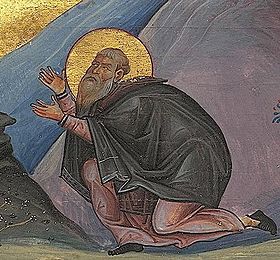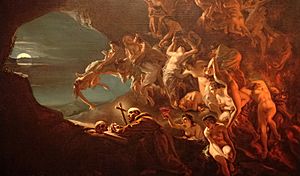Hilarion facts for kids
Quick facts for kids SaintHilarion |
|
|---|---|

Hilarion the Great, by Basil II, c.1000 (Vatican Library)
|
|
| Abbot | |
| Born | 291 AD Thabatha, south of Gaza in Syria Palaestina |
| Died | 371 AD Cyprus |
| Venerated in | Oriental Orthodox Church Eastern Orthodox Church Roman Catholic Church |
| Canonized | Pre-Congregation |
| Feast | October 21 |
Hilarion the Great (born 291 AD, died 371 AD) was a very religious man who lived alone in the desert. He followed the example of another famous saint, Anthony the Great. While Saint Anthony started Christian monasticism in Egypt, Saint Hilarion is known for starting it in Palestine. He is honored as a saint by many Christian churches.
Contents
Hilarion's Early Life
The main story of Hilarion's life comes from a book written by St. Jerome in 390 AD. This book helped spread the idea of living a simple, religious life. It also gives us a peek into what life was like in the 300s AD.
Hilarion was born in a place called Thabatha, near Gaza in ancient Syria. His parents were not Christian. He went to school in Alexandria, a big city, where he learned about public speaking. It was in Alexandria that he became a Christian. After that, he stopped enjoying popular entertainment like the theater. Instead, he spent his time going to church. St. Jerome said Hilarion was a thin and delicate young man.
Starting a Monastic Life
When Hilarion was fifteen, he heard about Saint Anthony the Great. Saint Anthony was famous throughout Egypt. Hilarion decided to visit him in the desert and stayed for two months.
Saint Anthony's home was often busy with people seeking help or healing. So, Hilarion returned home with some monks. By then, his parents had passed away. He gave his family's wealth to his brothers and to people in need. Then, he left for the wilderness to live a simple, religious life.
Life in the Desert

Hilarion went to a desert area near Majoma, which was the port of Gaza. This area was known for robbers. His friends and family warned him about the dangers. Because of this, he never stayed in one place for too long.
He carried very little with him: a rough linen shirt, a cloak made of animal skins from Saint Anthony, and a simple blanket. He moved around a lot and ate very little, usually only after sunset. He made baskets to support himself.
Hilarion lived a very hard and simple life in the desert. He sometimes felt sad or tempted to give up. To fight these thoughts, he fasted even more. Saint Jerome wrote that Hilarion became so thin "his bones scarcely held together."
He later built a small hut from reeds and grass. He lived there for four years. After that, he built an even smaller cell, which was more like a tiny tomb than a house. He slept on a bed of rushes and spent his time reading the Bible or singing hymns. He rarely washed his clothes and only changed them when they fell apart. He shaved his hair only once a year. Robbers once visited him, but they left him alone when they saw he had nothing worth stealing and wasn't afraid of them.
Saint Jerome described Hilarion's diet. He started with a small amount of lentils mixed with cold water. After three years, he ate dry bread with salt and water. Later, when his eyesight started to get bad and his skin became rough, he added a little oil to his food.
After 22 years in the desert, Hilarion became very famous in the region. People started coming to him, asking for his help. So many visitors came that Hilarion decided to move to more distant places. But people followed him everywhere. He first visited Saint Anthony's retreat in Egypt. Then he moved to Sicily, later to Dalmatia, and finally to Cyprus. He passed away there in 371 AD.
Amazing Miracles
Many miracles were said to have been performed by Hilarion. His first miracle was curing a woman from Eleutheropolis who had been unable to have children for 15 years. He also healed three children from a serious illness. He cured a charioteer who couldn't move his body and helped people who were believed to be troubled by evil spirits.
Hilarion's Monastery
Over time, a monastery grew around Hilarion's small cell. So many visitors came, especially women, that Hilarion eventually left the monastery to find more peace.
See also
- Chariton the Confessor (lived late 200s - c. 350), also thought to be a founder of monasticism in Palestine.
- Euthymius the Great (377–473), another saint who founded monasteries in Palestine.
- Paul of Thebes (c. 226/7-c. 341), known as "Paul, the First Hermit," who lived alone even before Anthony and Chariton.
- Sabbas the Sanctified (439–532), a monk and saint who founded several monasteries in Palestine.
- Saint Hilarion Castle in Cyprus. This castle is named after a different, less known saint.
 In Spanish: Hilarión para niños
In Spanish: Hilarión para niños

